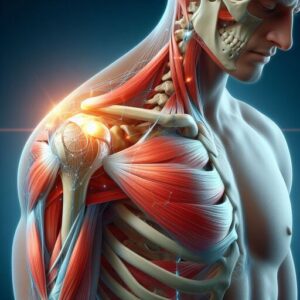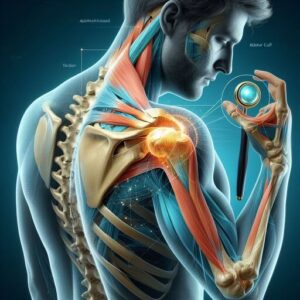Shoulder Impingement Syndrome
Shoulder impingement is a common source of shoulder discomfort and a common symptom of restricted arm movement.
This condition develops when the rotator cuff tendon, responsible for shoulder mobility, significantly rubs against nearby tissues and bones while raising the arm.
Shoulder Anatomy and Impingement Mechanism
Understanding the intricate anatomy of the shoulder joint is essential for fully comprehending shoulder impingement.
The shoulder’s many vital components, which include bones, muscles, tendons, and ligaments, provide a wide range of mobility.
The rotator cuff is a group of four tendons and muscles that stabilise the shoulder joint and provide movement to the arm.
The interplay of these muscles and tendons provides coordination and ease of shoulder movement.
But when you have an impingement in your shoulder, the rotator cuff tendon is open to pressure and friction from all directions, which means your arm will hurt and be uncomfortable whenever you move it.
Symptoms and Look
- Shoulder impingement can cause many symptoms, including mild discomfort and severe pain. Common symptoms include:
- Pain on the top and outside of the shoulder worsens with arm movement, mainly when the arm is raised above the head.
- Pain during the night frequently impairs sleep and overall quality of life.

The affected arm’s weakness or diminished strength makes it difficult to perform daily tasks and functional motions.
Varying degrees and durations of these symptoms are possible. While some people feel pain immediately, others must wait for their symptoms to worsen.
Diagnosis and Medical Evaluation
See a medical professional to determine the source and best course of therapy for persistent shoulder pain or discomfort.
A medical expert, usually a general practitioner (GP) or orthopaedic surgeon, will thoroughly evaluate your shoulder. This process includes a comprehensive physical exam and imaging studies, such as X-rays or an MRI.
The doctor will check your range of motion, strength, and capacity to endure pain during the examination.
This examination will help rule out rotator cuff tears and osteoarthritis as possible causes of shoulder discomfort and detect impingement.
Treatment Alternatives And Management Strategies
Conservative treatment methods, along with, in rare cases, surgical intervention, are utilised to alleviate shoulder impingement.
The severity of the symptoms, the underlying reasons, and the patient’s traits influence the therapy decision.
Conservative Treatments:
If you suffer from shoulder discomfort, one way to modify your activity is to avoid doing things that make it worse, such as lifting heavy objects or repeating the motions above.
Resting the shoulder may require making short-term adjustments to regular activities.
Physical treatment: A planned physical therapy programme focusing on shoulder strengthening, flexibility exercises, and posture correction can help improve shoulder function and pain relief.
An expert physiotherapist can customise the workouts to address individual weaknesses and improve recovery.
Pain relief: Nonsteroidal anti-inflammatory medicines (NSAIDs) or over-the-counter pain relievers can help reduce shoulder discomfort and inflammation.
However, these drugs are typically used as supplementary therapy and should only be used under the supervision of a physician.
Modalities: Ice packs and heat therapy can help reduce shoulder discomfort and inflammation.
Symptomatic relief can be obtained using ice packs for 15 to 20 minutes daily or the suggested heat therapy.
Advanced Treatments:
When other, more conservative treatments have failed to alleviate swelling and pain in the shoulder, injecting the joint with corticosteroids can provide temporary relief.
These injections are usually performed under fluoroscopic or ultrasound guidance to guarantee accuracy and precision.
Two other modern regenerative treatments aiding shoulder repair are platelet-rich plasma (PRP) injections and stem cell therapy.
Alternative methods may help certain patients while research into these medicines’ effectiveness continues.
If the symptoms persist after conservative treatment or if structural damage to the shoulder is discovered, surgical treatments may be necessary.
One surgical option for treating shoulder impingement is arthroscopic decompression, which entails altering or eliminating the structures that contribute to the problem.

Recovery and Rehabilitation
Following surgery or conservative treatment, a systematic rehabilitation programme is required to improve shoulder function and prevent problems from recurring.
Physiotherapy plays a crucial role in the recovery process by systematically enhancing the shoulder joint’s functional capacities, strength, and range of motion.
Prevention Strategies
Although it’s not always possible to prevent shoulder impingement, you can lessen your chances of getting it by following these steps:
The user’s failure to adhere to good ergonomics and posture can lead to unnecessary pressure on the shoulder and surrounding tissues from regular tasks.
Gradually increase activities: To avoid overstressing your shoulder muscles and tendons, it is recommended to ease into more strenuous workouts or exercise programmes.
Cross-training: A varied workout programme is a way to keep your shoulders healthy and free from overuse injuries.
Do shoulder-specific stretching and strengthening exercises regularly to keep your shoulders flexible and strong and reduce the risk of impingement.
A common cause of shoulder pain known as impingement syndrome can negatively impact a person’s ability to go about their daily lives.
Learning about the problem’s origins, symptoms, and treatment options can help one take preventative measures to address shoulder impingement and successfully avoid long-term consequences.
Prompt medical diagnosis, appropriate treatment, and rehabilitation can help many patients with shoulder impingement greatly reduce their symptoms and get back to their typical activities with modest restrictions.
References
- Mastering Shoulder Impingement: Expert Tips with Zlaant!. https://www.zlaant.com/blogs/news/mastering-shoulder-impingement-expert-tips-with-zlaant
- Shoulder Injury After A Motor Vehicle Accident (CTP Claim). https://www.physioparramatta.com.au/shoulder-injury-after-a-motor-vehicle-accident-ctp-claim/
- Shoulder Pain in The Woodlands, TX | Movement Orthopaedic. https://www.movementorthopaedic.com/areas-treated/shoulder/
The post Understanding Shoulder Impingement appeared first on Rehabilitation Therapy Preston.
The Article A Guide To Shoulder Impingement Syndrome appeared first on MCR Therapies.
The Article A Guide To Shoulder Impingement Syndrome Was Found On https://limitsofstrategy.com



It’s fascinating how our shoulders, often taken for granted, can reveal so much about our overall health and daily habits. Your exploration of shoulder impingement truly highlights the intricate balance between mobility and the potential for injury. Having dealt with shoulder discomfort myself, I can relate to the frustration that comes from restricted movement—it often affects not just physical activity, but also the joys of simple tasks.
You’ve really captured the essence of it. Shoulders are such a complex part of our anatomy, and it’s interesting how we often overlook their significance until something goes awry. I remember going through a phase of shoulder pain myself, and it was surprising to see how it affected not just my workouts but also routine activities like reaching for something on a high shelf or even carrying groceries.
You bring up such a crucial point about how much our shoulders really influence our daily experiences. It’s easy to overlook them until discomfort sets in, and then we start to notice how much we rely on those movements, from lifting a grocery bag to reaching for something on a high shelf. It’s like a reminder of how interconnected our bodies are—restrict one part, and it feels like a domino effect on everything else.
You’re spot on about how easily our shoulders can go unnoticed until they start causing us problems. I’ve often found myself taking for granted how much I depend on that range of motion until I do something as simple as reaching for a cup in my cabinet and wince a little. It makes you realize that our bodies have this incredible interconnectedness.
You’re right about how easily we can overlook our shoulders until they start sending us signals that they need attention. I had a similar experience recently when I twisted to grab something behind me, and I felt that familiar twinge. It’s funny how we often don’t think about the mechanics of our bodies until they remind us they’re not invincible.
It’s interesting how our bodies have their own subtle ways of reminding us to pay attention. That twinge you felt is a common experience many people can relate to—one moment you’re moving easily, and the next, your body, seemingly out of the blue, lets you know it’s not as resilient as you thought.
Totally get what you’re saying. It’s wild how much we rely on our shoulders until they decide to act up. It can feel like the simplest tasks suddenly become a mini obstacle course. I’ve had those moments, too, and they really do make you stop and think about how every little movement is interconnected — like a chain reaction, you know?
I totally resonate with your thoughts on how easily we overlook our shoulders until something goes wrong. It’s interesting how something so integral to our daily movements can become a source of discomfort and frustration. For me, it was surprising to discover how much shoulder pain could limit not just physical activities but also the little things, like reaching for something on a high shelf or even carrying my grocery bags.
You’ve hit on something really important here. Shoulders are such complex joints, and it’s easy to overlook them until something goes wrong. The way they can affect daily life is definitely a game changer—like when reaching for that itch on your back becomes an Olympic event.